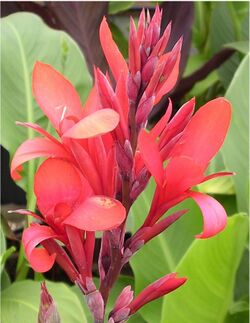Biology:Canna coccinea
| Canna coccinea | |
|---|---|

| |
| Scientific classification | |
| Kingdom: | Plantae |
| Clade: | Tracheophytes |
| Clade: | Angiosperms |
| Clade: | Monocots |
| Clade: | Commelinids |
| Order: | Zingiberales |
| Family: | Cannaceae |
| Genus: | Canna |
| Species: | C. coccinea
|
| Binomial name | |
| Canna coccinea Mill.
| |
Canna coccinea is a species of the Canna genus, belonging to the family Cannaceae. A native of northern Argentina, it was introduced in England from South America in 1731.[1][2]
Description
Herbs up to 2 m tall.[3] Full heads of raspberry red flowers held high over the deeper green leaves. Orange or red staminodes (usually 2). The inflorescence stalk generally elongated and not branched. The fruits contain 3 to 5 seeds. The inflorescence stalk is triangular in cross-section and acutely angled; with three distinct longitudinal ridges.[4]
Taxonomy
Paulus Johannes Maria Maas from Netherlands[5] and Nobuyuki Tanaka from Japan , both experts in the taxonomy of genus Canna, assign different classifications for this species.
Dr Maas considers C. coccinea to be a synonym of C. indica L., however, Dr Tanaka's DNA-based approach shows that species in the Canna indica complex can be clearly distinguished from other taxa, as a result he recognises it as a separate species.[6]
Cultivation
C. coccinea is hardy to zone 10 and is frost tender. In the north latitudes it is in flower from August to October, and the seeds ripen in October.[3]
Ecology
The species is invasive in New Caledonia.[7]
See also
- Canna
- List of Canna species
- List of Canna cultivars
References
- ↑ Johnson's Gardeners Dictionary, 1856
- ↑ Kew Gardens, Checklist of plant families
- ↑ 3.0 3.1 Cooke, Ian, 2001. The Gardener's Guide to Growing cannas, Timber Press. ISBN:0-88192-513-6
- ↑ "Canna coccinea in the Claines Canna Collection". http://www.clainescanna.co.uk/Canna_coccinea.htm.
- ↑ Segeren, W. & P. J. M. Maas. 1971. The genus Canna in northern South America. Acta Bot. Neerl. 20(6):676.
- ↑ Tanaka, N. 2001. Taxonomic revision of the family Cannaceae in the New World and Asia. Makinoa ser. 2, 1:34–43.
- ↑ Hequet, Vanessa (2009) (in fr). LES ESPÈCES EXOTIQUES ENVAHISSANTES DE NOUVELLE-CALÉDONIE. pp. 17. http://horizon.documentation.ird.fr/exl-doc/pleins_textes/divers12-08/010052239.pdf.
Further reading
- Adams, C. 1972. Flowering plants of Jamaica. (F Jam)
- Cabrera, A. L., ed. 1965–1970. Flora de la provincia de Buenos Aires. (F BuenAir)
- Fournet, J. 1978. Flore illustree des phanerogames de Guadeloupe et de Martinique. (F GuadMart)
- Gómez-Pompa, A. & V. Sosa, eds. 1978–. Flora de Veracruz. (F Veracruz)
- Howard, R. 1974–1989. Flora of the Lesser Antilles. (F LAnt)
- León (J. S. Sauget) & Alain (E. E. Liogier). 1946–1962. Flora de Cuba.; suppl. 1969 (F CubaLeon)
- Reitz, R., ed. 1965–. Flora ilustrada catarinense. (F SCatarin)
- Walker, E. 1976. Flora of Okinawa and the southern Ryukyu Islands. (F Okin)
- Woodson, R. E. & R. W. Schery, eds. 1943–1980. Flora of Panama. (F Panama)
External links
- {{citation
| mode = cs1 | title = Canna coccinea | work = Germplasm Resources Information Network (GRIN) | url = | publisher = [[Organization:Agricultural Research ServAgricultural Research Service (ARS), United States Department of Agriculture (USDA) | access-date = }}
Wikidata ☰ Q3926665 entry
 |

